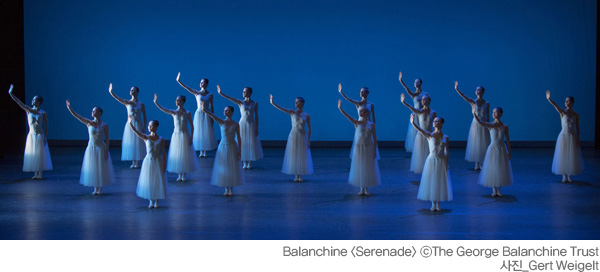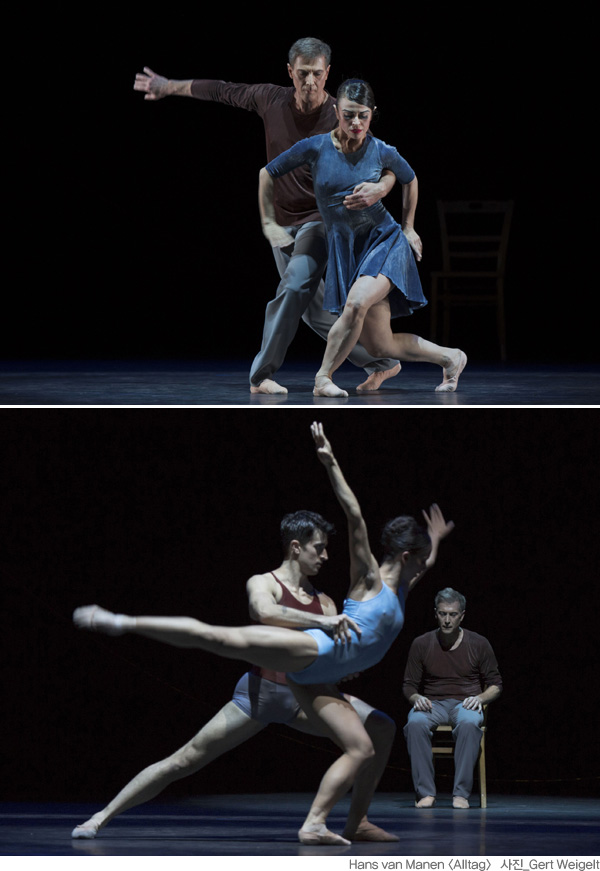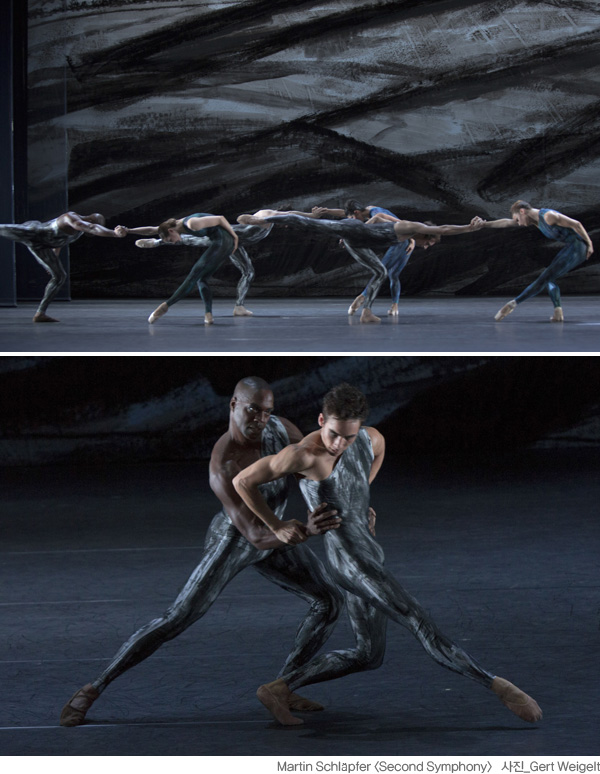리뷰
The Ballett am Rhein brilliantly presented their program 〈b. 21〉 to viewers young and old in the nearly sold-out Düsseldorfer Opernhaus on this year’s November 27th.
A spark ignited within the ensemble that carried through the entire evening: glimmering in the classic 〈Serenade〉 by George Balanchine, glowing in the world premiere of 〈Alltag〉 by Hans van Manen, and exploding in the the Brahms 〈Second Symphony〉 with fulminant choreography by company leader Martin Schläpfer.
Originally, a different work had been set to follow the premiere of van Manen's 〈Alltag〉 in this three-part ballet evening. But unfortunately, choreographer Terence Kohler was forced to cancel due to illness, so Schläpfer presented his own 2013 work 〈Second Symphony〉 instead. A fortunate decision.
The evening opened with 〈Serenade〉. George Balanchine choreographed this piece in 1934 for his students at the American School of Ballet, and it really does have an etude-like character in the way it draws from tradition, and the way its hand and arm gestures are peppered with quotations from and allusions to 19th century romantic ballet. At the same time, 〈Serenade〉 prevails as one of the first great works that lead into a new era of dance. The dancers, wearing pointe shoes and refined tutus, are liberated from pomp and glitter and must prove their abilities quickly and virtuosically in ever-changing constellations.
After experiencing the pleasure of live music (the superior Düsseldorf Symphony under the baton of J. Hochstenbach), any canned soundtrack used on that same evening falls on disappointed ears. Accoustically, 〈Alltag〉 did not succeed. Perhaps this piece should have opened the evening.

In 〈Alltag〉 (Everyday), we see one dancer (Martin Schläpfer) on stage, who plays a choreographer struggling for inspiration. At first – testing himself – he ventures a few steps and sequences. Then, as he grows more confident, he dances more expansively until a Muse (?) appears for a duet. Van Manen quotes from Schläpfer's own choreography to a soundtrack of Mahler and Bach. Schläpfer ends, before he turns and leaves, lost in contemplation on a chair. He doesn't look up again. His thoughts have already been transformed. Before his inner eye – and for the audience in reality – a young couple moved and effortlessly translated the thoughts of this choreographer into flesh and blood and living dance.
That sounds simple, and it is. In the positive sense of the word.
The 82-year-old Hans van Manen does not circumnavigate; he strips his choreographic inspiration down so that only the most important elements remain. Van Manen does not follow the trend of pursuing constant and supposed novelty. He rarely choreographs anymore abroad, but for Schläpfer, who also performed in celebration of van Manen's 80th birthday, he makes an exception: this is the expression of a long friendship.
And Schläpfer himself? He fills his role as dancer and protagonist with body and soul, just as he expects from his own dancers. In a newspaper interview he said about himself, “ 'Everyday' (〈Alltag〉) in the sense of being secure is not something I am familiar with.” All the more courage to take on a challenge like this one.
What follows next grips the viewer in its spell from the onset.

As if painting with ink, Schläpfer lets his ensemble sweep rapidly and virtuosically through the 〈Second Symphony〉 of Brahms in great, airy arcs. Here, in the final section of the evening, the ensemble finds their own unparallelled and completely unique dance-language. Here, they are in their element – like spirits of the forest or fairytale beings of the water on whose banks Brahms wrote this composition. Visual references to nature – to Wörthersee, nestled in the Carinthian mountains – ring in the distance. The back wall (Keso Dekker) shows abstract waves; the wings are not black drapes, but rather transparent waterways made by hanging, clear plastic, which visibly highlights the high pulse of this choreography.
Schläpfer creates a complex, multifaceted cosmos within each moment when he lets his dancers rush across the stage like the wind. He skillfully offsets his pictures by choreographing several groups that dance simultaneously, each with its own dynamic and motif-related movement, layering several tempos over each other. Plasticity and focus emerge both in the visual design and the movement content. It's like a Japanese zen garden, in which differing levels are a conscious way of offering the eye relaxation through depth effect and three-dimensionality.
The virtuosity of Schläpfers dancers, still in ballet slippers here, connects classic and contemporary elements. They explode into jumps while turning with rowing, circular elbows, move their heads idiosyncratically and articulate the hands – then attack the floor with elegance and control before continuing to turn and twirl with the same verve, come to standing again and seamlessly spiral into the next rotation, the next jump. The consolidated unison in trios or duets during this first movement formed a unique compositional and choreographic density that left the viewer breathless.
There is no specific “male” or “female” dance-language here. The ensemble draws from an artificial movement vocabulary, bringing those who can master it in one breath together into one group. Nevertheless random and ephemeral characters emerge: gnomes and imps, half-beings, which hang somewhere in the range of flight. They whir and flutter, appear at breakneck speed, dissolve again, then leave someone behind who leads into the next sequence and new motif.
In the second movement, a sextet dances on pointe again, but in a natural manner completely different from that in the first part of the evening: one almost forgets the pointe shoes – the dancers seem to rest, breathing freely in their bodies. The scene pulses dynamically with extreme musicality, yet is more stationary than before.

Marlúcia do Amaral's solo in the third movement is one of the evening's highlights. She nuances even the smallest movements, and her dancing counterbalances the entire orchestra. Maintaining a slow tempo, yet high dynamic, she engages in dialogue with herself: embodies multiple souls in one breast, fights against invisible chains – against the tightening oppression of her own outer skin. One memorable image is the way she traverses the stage in even arcs, floating backwards on pointe in silence after the orchestra fades, before disappearing into the last wing. At this – even before the beginning of the fourth movement – the audience must applaud.
Unforced references to 〈Swan Lake〉 and Pina Bausch echo in diagonal lines here, creating a connection to 〈Serenade〉.
The final picture is the rear view of an oblivious group with their arms rowing overhead. They stop suddenly. One member steps out and picks up the rubber ducks that were placed at the edge of the stage before by the sextet, and gingerly cradles them in his arm. That was a joke!
There is much applause, and viewers leave the theater with many long-lasting impressions. Fortunately for those who have not yet been able to get tickets, there will be an extra performance on December 26: a Christmas present from the Ballett am Rhein ensemble to the public.
translated by hrgb
....................................................................
Ballett am Rhein 〈b.21〉
비행 중 어느 곳
Andrea K. Schlehwein
지난 11월 27일, 독일의 무용단 발레 암하임(Ballett am Rhein)은 노소를 불문한 많은 관객들의 이목을 주목시켜 매진을 기록하며 독일 뒤셀도르프 오페라하우스에서 〈b.21〉의 공연을 선보였다.
공연 당일은 이어진 세 작품간의 앙상블이 빛을 발했다. 세 작품은 조지 발란신(George Balanchine)의 의 고전작인 <세레나데>(Serenade), 안무가 한스 반 마넨(Hans van Manen)의 첫 프리미어 작인 <알타그>(Alltag), 컴퍼니 감독 마틴 슈랍퍼(Martin Schläpfer)가 연출한 브람스의 <세컨드심포니>(Second Symphony)였다.
원래는 첫 프리미어 작 <알타그>에서 수정된 다른 작품이 소개되기로 하였으나, 안무가 테렌스 콜러(Terence Kohler)의 건강상 사유로 마틴 슈랍퍼가 2013년 공연을 올린 작품을 이번 공연에서 대신 올려야 했다. 이는 행운이었다.
먼저 공연은 <세레나데>로 막을 올렸다. 조지 발란신은 1934년 아메리칸 발레스쿨에서 학생들을 위해 이 작품을 처음 안무하였다. 이 작품은 전통을 겸비하고 19세기 로맨틱 발레의 양상을 띤다. 동시에, <세레나데>는 새로운 무용의 시대를 처음 연 작품으로 명성이 매우 높다. 화려함과 반짝이는 복장에서 벗어나 깔끔한 복장을 한 무용수들은 지속해서 바뀌는 단체 안무 속에서 빠르게 움직이며 실력을 뽐낸다.
뒤셀도르프 심포니 교향악단의 라이브 음악에 공연된 <세레나데>를 본 뒤라면 어떤 음악일지라도 CD사운드 트랙이라면 관객들에게 실망을 안겨주었을 것이다. 사운드적인 면으로 <알타그>는 그다지 성공적이지는 못했다. <알타그>가 첫번째 순서로 나왔다면 더 나았지 않을까 여겨진다.
<알타그>는 독일어로 ‘일상‘이라는 뜻이다. 이 작품에는 한 명의 무용수, 마틴 슈랍퍼가 출연하여 영감을 받지 못해 분투하는 안무가의 움직임을 표현한다. 처음에는 자신을 시험하며 몇 걸음을 나서고, 이를 반복한다. 그리고는 조금 자신감을 얻으며 더 과장된 움직임을 보이다가 여성무용수가 등장하며 듀엣을 추게 된다.
한스 반 마넨은 마틴은 의자에서 사색에 잠기며 공연을 마무리한다. 그리고 그의 사색은 현실로 변형된다. 그의 상상속에 그려진 어린 커플이 등장하여 그의 머릿속 안무에 피와 살을 붙여 생명을 불어넣는다.
말로만 하면 꽤 간단한 것처럼 여겨진다.
올해 82세의 한스는 더 이상 모험을 하지 않으려 했다. 그는 안무에 불필요한 장식을 걷어내고 중요한 기본만 남도록 한다. 한스는 유행을 따르지 않으며 해외공연의 안무는 삼가하고 있다. 하지만 마틴 슈랍퍼에게는 예외였다. 이는 한스와 마틴의 돈독한 우정덕분이다..
그리고 마틴은 이 공연에서 무용수로서 역할을 다하며 자신의 몸과 마음의 주인으로서 스토리를 잘 이끌어나간다. 이는 그가 안무를 해주는 다른 후배 무용수들에게 바라는 점이기도 하다.
한 언론 인터뷰에서 그가 말하길‚“ <알타그>는 제가 편하게 생각하는 익숙한 주제는 아닙니다” 라고 말하며 이 작품에는 도전정신이 필요했다고 언급했다.
그리고 공연은 마지막 작품으로 관객들의 시선을 사로잡는다.
마치 잉크가 퍼져나가듯 마틴은 그의 앙상블 멤버들이 무대를 휩쓸고 지나며 브람스의 세컨드 심포니의 시작을 이어나가도록 한다.
여기에서부터, 공연의 마지막을 장식하며, 앙상블 무용수들이 그들만의 움직임으로 이야기를 펼친다. 그들은 각각의 다른 요소가 된다. 마치 숲이나 동화속의 자연요소들이 영혼을 지니듯 브람스가 작곡한 음악의 요소가 된다. 보터시(Wörthersee) 호수를 묘사하는 듯한 시각적인 광경이다. 배경화면은 추상적인 물결모양을 그려내고 무대의 양쪽 사이드는 검은 천대신 투명한 플라스틱이 자연스럽게 물결의 분위기를 내며 매달려있다. 이와 같은 장치는 안무를 더욱 돋보이게 했다.
마틴은 무용수들이 무대를 바람처럼 휩쓸고 지나갈 때마다 복잡하면서도 질서정연한 코스모스를 창조한다. 그리고 그는 여러 그룹의 앙상블을 동시에 춤추게 하며 다양한 박자를 이루게 하는 그림을 그려낸다. 시각적인 요소와 움직임자체를 통하여 관객들로 하여금 집중하도록 한다. 마치 일본의 전통정원처럼 각자가 다른 층의 것들이 계속하여 움직임으로서 3D 효과를 내며 시각적 요소에 더욱 깊이를 보여준다.
그리고 마틴의 무용수들은 전통과 현대무용의 요소를 이어 나간다. 그들은 팔을 저어가며 턴을 돌고 동시에 점프를 한다, 팔꿈치의 움직임과 머리를 기이하게 돌리며 손의 움직임을 보인다. 그리고, 땅을 치고 다시 중심을 잡으며 같은 동작을 반복한다. 이렇게 반복적인 안무를 모두가 돌림노래처럼 돌아가며 이어간다. 2명 또는 3명이 이루는 이 동작은 구조적이고 질적인 화합을 보이며 숨막히는 공연을 선보인다.
이 작품에서는 남성이나 여성의 언어가 따로 존재하지 않는다. 앙상블은 인위적인 동작의 언어를 한 그룹으로서 표현한다. 그럼에도 불구하고 도깨비나 요정 같은 임의의 캐릭터가 등장한다. 이들은 윙윙거리며 허둥댄다. 빠른 속도로 등장했다가 다시 느려지고, 그 다음 동작을 위한 복선을 보일 한 사람만을 남겨두고 퇴장한다.
그 다음 장면으로 6명의 무용수가 등장한다. 첫 장면과는 완전히 다른 모습이며 토슈즈도 거의 신지 않는다. 무용수들은 전보다 조금 더 숨을 쉬고, 더 자유롭게 움직인다. 전보다는 조금 안정된 모습이지만 여전히 음악적인 요소를 겸비하고 있다.
말루시아 도 아마갈(Marlúcia do Amaral)의 솔로가 바로 이 공연의 하이라이트였다. 그녀는 아주 미묘한 움직임도 표현을 하며 오케스트라의 음악에 반하여 춤을 춘다. 느린 템포지만 다이나믹한 움직임으로 자신과의 대화를 시작한다. 가슴에는 여러가지 감정을 담고 보이지않는 쇠사슬과 싸우는듯 그녀 자신과의 싸움을 몸으로 표현한다.
가장 인상적인 장면은 그녀가 반원모양을 그리면서 무대를 가로지르다가 오케스트라가 낮은 소리로 연주를 하면 발끝으로 조용히 뒷걸음질을 치며 무대 옆으로 사라지는 장면이었다. 이 장면에서 그 다음 동작이 시작되기 전임에도 불구하고 관객들은 박수를 쳤다. 그리고 공연은 이렇게 다시 처음 공연된 <세레나데>로 연결된다.
마지막 장면은 저 멀리에서 무리들이 일제히 팔을 머리위로 하고 노를 젓는 장면이다. 그들이 갑자기 멈추자 한 무용수가 한걸음 나온다. 그리고는 작은 고무 오리 장난감을 들고는 조심스럽게 팔에 안는다. 장난을 치고 있는 셈이다.
박수소리가 우렁찼다. 관객들은 많은 인상을 남기고 자리를 떠났다. 다행스럽게도 아직 공연을 보지 못했다면 12월 26일에 공연이 또 있을 것이다. 발레 안 하임의 크리스마스 선물이다.
● Andrea K. Schlehwein writes and realizes artistic concepts, working in visual as well as theater arts as a curator, choreographer and director. AKS has shown her work in Austria, Germany, Turkey, Indonesia and Korea. Since 2012, Andrea K. Schlehwein has served as a guest professor of choreography at the Korea National University of Arts, living and working both in Seoul and in Millstatt (Carinthia).
● 독일어→영어 번역 : hrgb
영어→한국어 번역 : 장수혜




